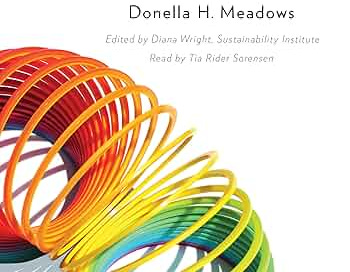#178 What is a System?
Have you ever noticed how traffic jams form even when there’s no accident? Or why some companies seem to innovate effortlessly while others struggle? Or why some diets fail despite the best intentions? The answer lies in systems thinking—a way of seeing the world not as isolated events, but as interconnected systems.
I recently started reading Thinking in Systems by Donella Meadows, although I am only a few pages in, it has given me a completely different perspective of the world. This book introduces a simple yet powerful idea: everything around us operates as part of a system—from nature to businesses to societies. But what exactly is a system? And why should we care?
A system is a collection of elements that interact with each other to form a whole. These elements can be physical objects (like parts of a car), processes (like supply chains), or even abstract concepts (like economic policies). A system is more than just a sum of its parts. It exhibits emergent behavior—meaning the whole system has properties that the individual parts alone do not. For example, a single neuron in your brain doesn’t have consciousness, but together, billions of neurons create the ability to think.
Every system consists of three essential items: Elements, Interconnections and Purpose/Function.
Elements are the individual parts that make up a system. They can be tangible (like machines in a factory) or intangible (like company culture). While elements are important, simply having them doesn’t create a functional system. A football team isn’t just a group of players standing on a field—they need to interact and follow a strategy. At the same time, changing the elements of a system does not change the behavior of a system. If you change all the players of a football team, the game will still remain football and not become baseball.
Interconnections are the relationships and interactions between elements. These determine how elements work together and influence each other. Interconnections can be rules, information flows, or physical links. Some are visible (train tracks connecting cities), while others are invisible (social norms influencing behavior). Changing interconnections dramatically changes system behavior. A football team with poor coordination will struggle, even if it has the best players. A company with great talent but no collaboration won’t succeed.
The purpose (or function) of a system is what it actually does, not necessarily what it says it does. The purpose emerges from the system’s behavior over time. A system’s true purpose is revealed by its actions, not its stated mission. A company may claim to “care about customers,” but if its main actions focus on cost-cutting at the expense of service, its real purpose is maximizing profit. Purpose is often the hardest thing to change in a system. If a government is structured around power retention rather than public service, policy changes alone won’t fix the system.
Now let’s apply systems thinking to a real-world problem: traffic congestion. Traffic is a complex system where elements, interconnections, and purpose all interact to create the experience we see on the road every day.
A traffic system consists of:
• Elements – Cars, buses, pedestrians, traffic lights, roads, highways, intersections, drivers.
• Interconnections – Traffic rules, road signs, speed limits, driver behavior, traffic signals, public transport schedules.
• Purpose – To move people and goods efficiently from one place to another.
Now, if we modify the elements of the system, we introduce new players or remove existing ones.
Adding More Roads? Many cities try to solve congestion by building more roads or adding lanes.What might happen? Initially, congestion may decrease. But over time, more people drive because it’s more convenient, bringing congestion back. Changing elements alone often does not solve congestion - it just shifts the problem unless interconnections and purpose are also adjusted.
Interconnections are the rules, incentives, and relationships between elements. Modifying them changes system behavior without necessarily adding new elements.
Adjusting Traffic Signals? If we implement smart traffic lights that adapt to real-time traffic flow, we optimize movement. What happens? Traffic flows more smoothly, reducing unnecessary stops and improving travel times. Interconnections shape system behavior more effectively than just changing elements. A city that discourages car usage through pricing or better public transport solves congestion better than just adding more roads.
The purpose of the traffic system determines its long-term behavior. If we redefine the goal, the system changes in unexpected ways.
Shifting the Purpose from “Moving Cars” to “Moving People”? Many traffic systems are designed around cars, not people. Roads, intersections, and signals prioritize vehicles over alternative transportation. What if we redefined the purpose? Instead of aiming to reduce car congestion, the goal could be to move the most people efficiently.
There is a real world case study which proves that changing the purpose improves the system by leaps. Los Angeles expanded freeways but still suffers from some of the worst traffic congestion in the world. Whereas Amsterdam shifted focus to biking and public transport—today, over 60% of trips in the city are made without cars, reducing congestion significantly. The biggest system transformations happen when purpose shifts. If we focus on “efficiency for all commuters” rather than just “faster cars,” we create long-term solutions.
Traffic congestion isn’t just about cars on the road—it’s a system problem. Simply adding more roads (changing elements) often fails. True solutions come from redesigning interconnections (incentives, policies) and even rethinking the entire purpose (shifting to moving people rather than cars).
This logic applies to businesses, economies, and even personal habits—if you’re struggling with a system (a failing project, unhealthy lifestyle, or inefficient process), ask yourself: Can I change the elements? Can I modify interconnections? Can I redefine the purpose entirely?
That’s the power of systems thinking.
Curated Picks for the Week






